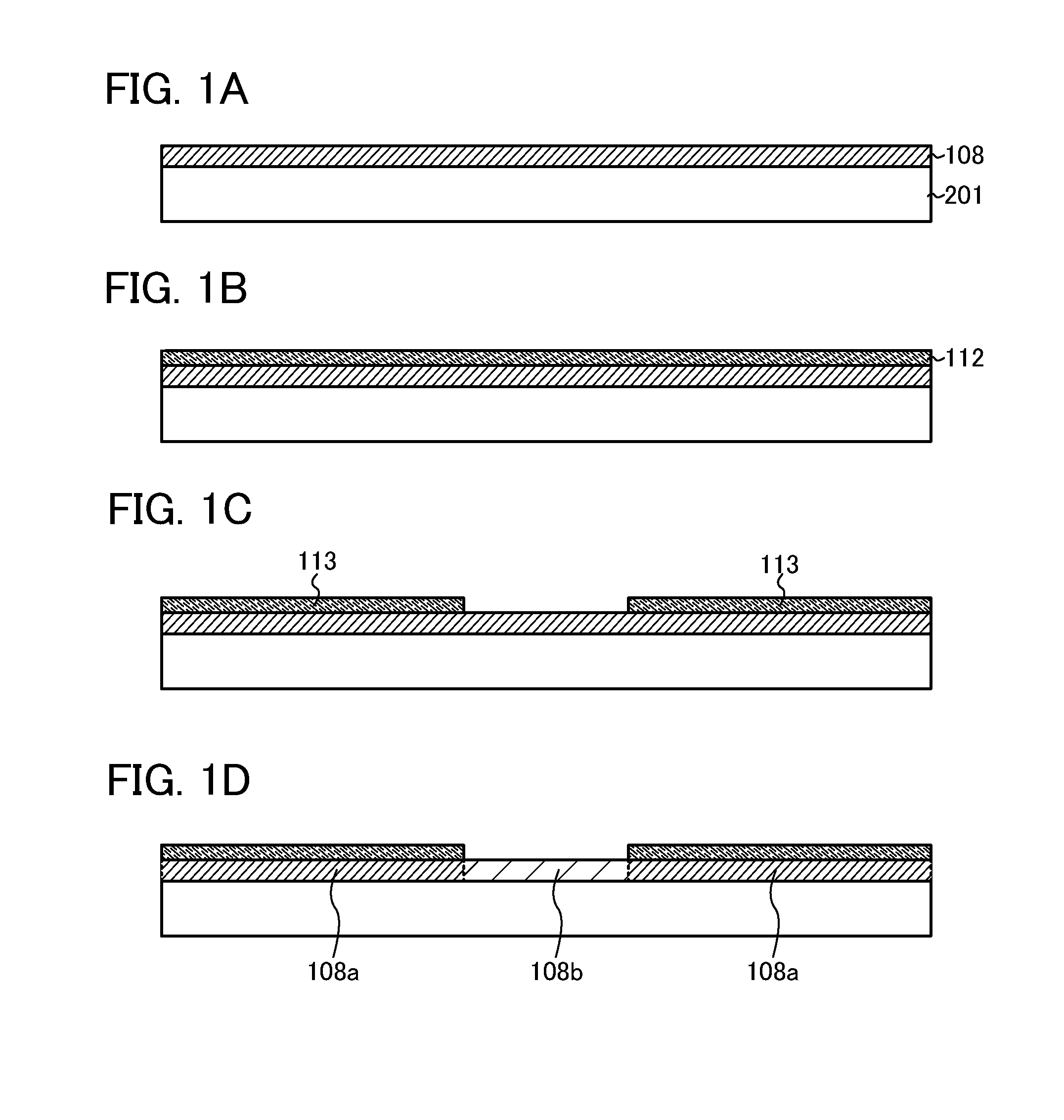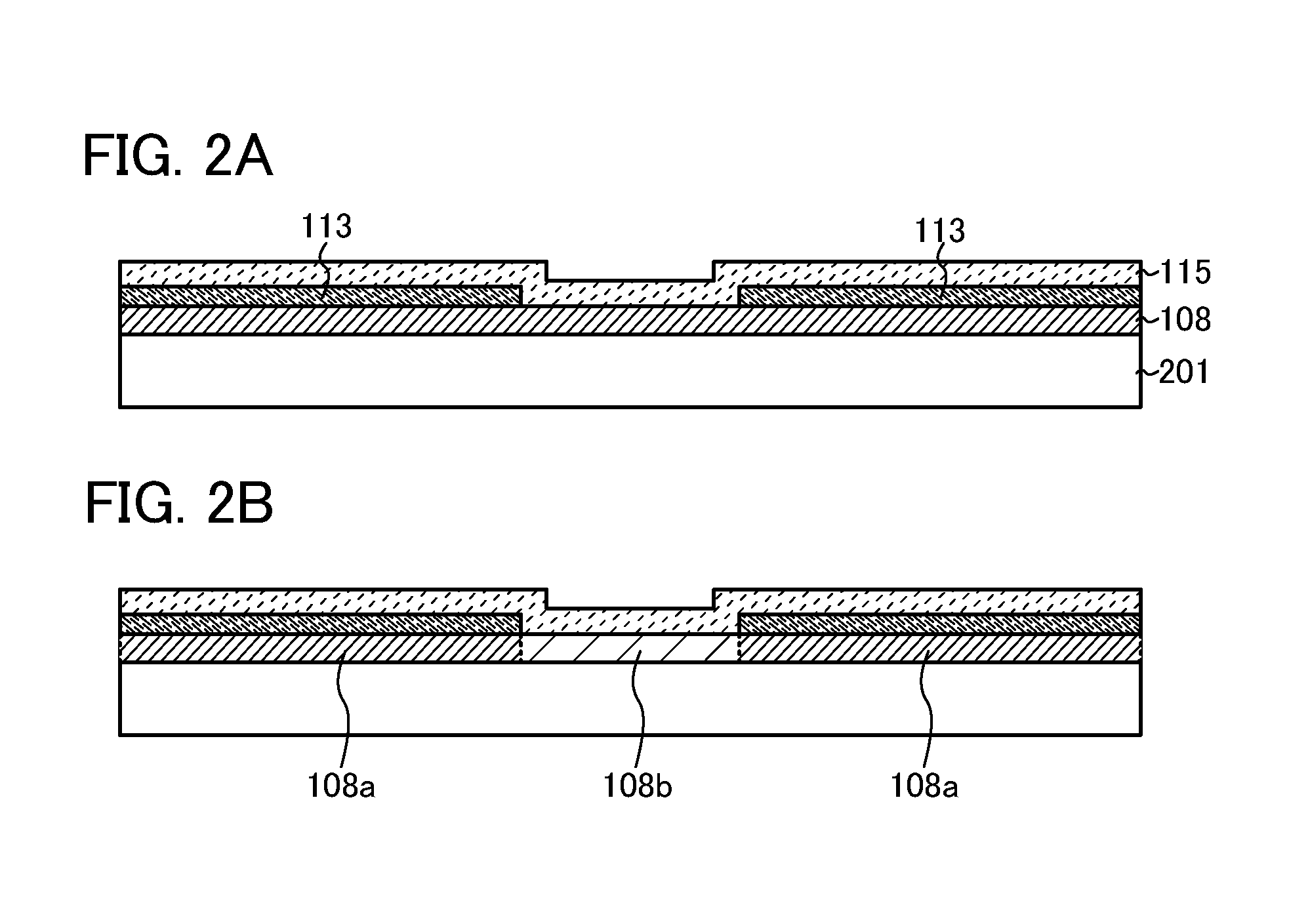Method for manufacturing transistor
a manufacturing method and transistor technology, applied in the direction of electroluminescent light sources, semiconductor/solid-state device testing/measurement, electroluminescent light sources, etc., can solve problems such as difficulty in lowering resistance, and achieve the effect of variable conductivity between the source region and the drain region
- Summary
- Abstract
- Description
- Claims
- Application Information
AI Technical Summary
Benefits of technology
Problems solved by technology
Method used
Image
Examples
embodiment 1
[0061]In this embodiment, an example of a method for manufacturing a transistor is described with reference to drawings.
[0062]First, an oxide semiconductor layer 108 including hydrogen is formed over a substrate 201 (see FIG. 1A).
[0063]The oxide semiconductor layer 108 can be formed using a material of which electric resistance is lowered by addition of hydrogen or deuterium. For example, the oxide semiconductor layer 108 can be formed using an oxide semiconductor including at least indium, zinc, gallium, and hydrogen. In this case, deposition is performed by a sputtering method using an oxide semiconductor target including In, Ga, and Zn (for example, In2O3:Ga2O3:ZnO=1:1:1) while a hydrogen gas is introduced, so that the oxide semiconductor layer 108 including hydrogen can be formed.
[0064]The oxide semiconductor layer 108 is formed while hydrogen is introduced into a deposition atmosphere, so that hydrogen can be uniformly added into the oxide semiconductor layer 108 even when the ...
embodiment 2
[0091]In this embodiment, an example of a method for manufacturing a bottom-gate transistor which is described in Embodiment 1 is described with reference to drawings.
[0092]First, a gate electrode 102 is formed over the substrate 100 and then a gate insulating layer 104 is formed over the gate electrode 102. After that, a source electrode layer 106a and a drain electrode layer 106b are formed over the gate insulating layer 104 (see FIG. 3A).
[0093]The substrate 100 may be any substrate as long as it is a substrate having an insulating surface. A glass substrate can be used, for example. Alternatively, as the substrate 100, an insulating substrate which is formed using an insulator such as a ceramic substrate, a quartz substrate, and a sapphire substrate; a semiconductor substrate which is formed using a semiconductor material such as silicon and whose surface is covered with an insulating material; and a conductive substrate which is formed using a conductor such as metal or stainles...
embodiment 3
[0127]In this embodiment, an example of a method for manufacturing a bottom-gate transistor, which is different from the manufacturing method described in Embodiment 2, is described with reference to drawings.
[0128]First, the gate electrode 102 is formed over the substrate 100 and then the gate insulating layer 104 is formed over the gate electrode 102. After that, the oxide semiconductor layer 108 is formed over the gate insulating layer 104 (see FIG. 6A).
[0129]Next, after the oxide semiconductor layer 108 is etched to form the island-shaped oxide semiconductor layer 110 (see FIG. 6B), the hydrogen barrier layer 112 is formed over the oxide semiconductor layer 110 (see FIG. 6C).
[0130]Next, the hydrogen barrier layer 112 is etched so that parts of the hydrogen barrier layer 112 (the hydrogen barrier layers 113) are left and a surface of part of the oxide semiconductor layer 110, which is formed over the gate electrode 102, is exposed (see FIG. 6D).
[0131]Next, hydrogen is desorbed fr...
PUM
 Login to View More
Login to View More Abstract
Description
Claims
Application Information
 Login to View More
Login to View More - R&D
- Intellectual Property
- Life Sciences
- Materials
- Tech Scout
- Unparalleled Data Quality
- Higher Quality Content
- 60% Fewer Hallucinations
Browse by: Latest US Patents, China's latest patents, Technical Efficacy Thesaurus, Application Domain, Technology Topic, Popular Technical Reports.
© 2025 PatSnap. All rights reserved.Legal|Privacy policy|Modern Slavery Act Transparency Statement|Sitemap|About US| Contact US: help@patsnap.com



